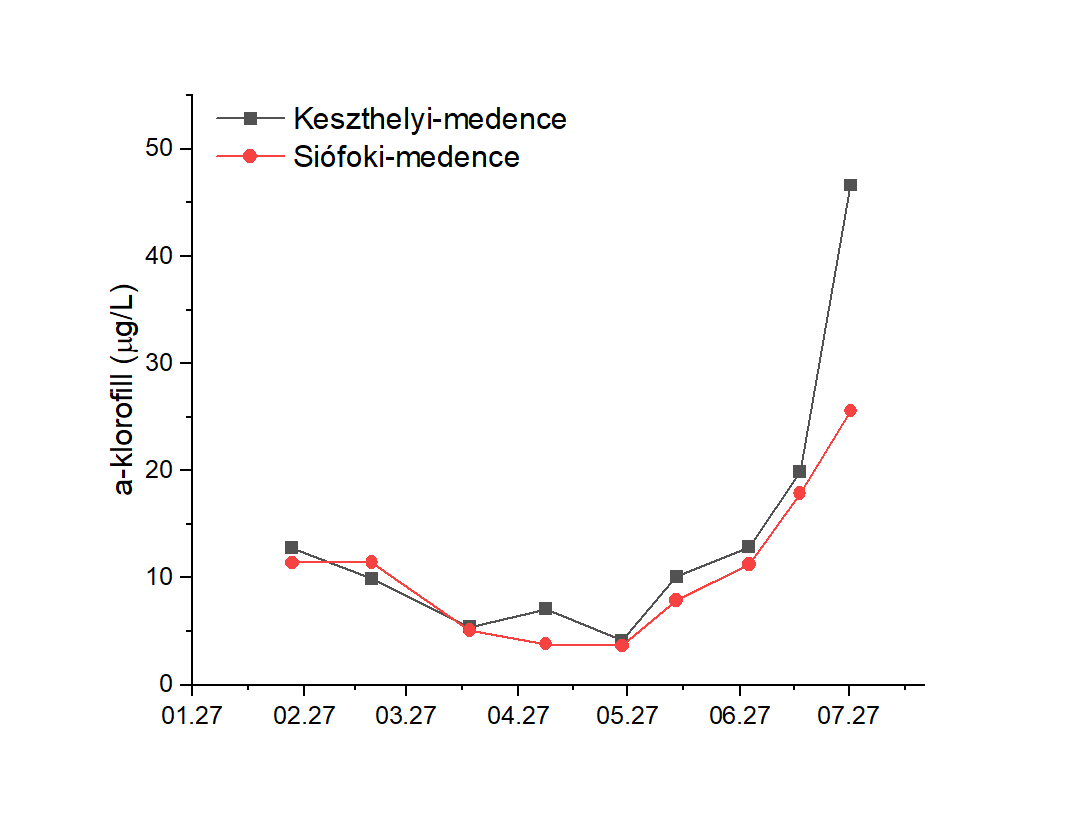Despite the recent windy and sometimes stormy weather, algal biomass has started to increase over the past two weeks, particularly in the western parts of the lake, in the Keszthely and Szigliget basins. In these areas, the concentration of chlorophyll-a exceeded 45 µg/L, while in the central and eastern basins (Szemes and Siófok) concentrations were between 25–30 µg/L. Thus, the trophic gradient along the lake’s longitudinal axis — well known from earlier decades (Figures 2–3) but largely absent over the past year — has reappeared. The measured chlorophyll-a concentrations remain below the World Health Organization (WHO) threshold of 75 µg/L, which indicates the maximum algal biomass allowable in recreational waters (in cases where cyanobacteria are dominant).

Figure 1. Changes in algal biomass (chlorophyll-a concentration) in the Keszthely and Siófok basins up to the end of July 2025.
 Figure 2. Changes in algal biomass (chlorophyll-a concentration) along the lake’s longitudinal axis, 28 July 2025.
Figure 2. Changes in algal biomass (chlorophyll-a concentration) along the lake’s longitudinal axis, 28 July 2025.
Remote sensing methods tracking the spatial and quantitative distribution of algal biomass also confirm that biomass levels in the western parts of the lake are currently nearly double those observed in the central and eastern basins (Figure 3).

Figure 3. Changes in algal biomass (chlorophyll-a concentration) in Lake Balaton (Landsat, 4 August 2025).
Regarding phytoplankton composition, the share of filamentous nitrogen-fixing cyanobacteria and dinoflagellates, typical for summer, has further increased in Lake Balaton (Figures 4–5). By mid-July, their biomass share exceeded 80% in the Siófok Basin and 90% in the Keszthely Basin. In the eastern basin, cyanobacteria are markedly more abundant and clearly dominant, whereas in the Keszthely Basin dinoflagellates prevail. Another noteworthy difference is that in the eastern basin the presence of Planktothrix and Oscillatoria species (cyanobacteria unable to fix molecular nitrogen) is remarkable, while in the western areas the appearance and spread of needle-like colonies of the filamentous cyanobacterium Aphanizomenon flos-aquae are striking.
Other common phytoplankton taxa in Lake Balaton, such as green algae, diatoms, and cryptophyta algae, made up only a small share of the biomass, typically not exceeding 3%.
The algal situation in Lake Balaton in the coming weeks will largely depend on weather conditions. Calm, hot summer days could favor the proliferation of certain algal species.


Figure 4. Phytoplankton composition in the Siófok and Keszthely basins in mid-July 2025.
Figure 5. Microscopic image of planktonic algae at 200x magnification (Keszthely Basin, 28 July 2025). The picture shows algal species typical for Lake Balaton in summer: two dinoflagellate species (Ceratium hirundinella with a stouter body form and Ceratium furcoides with a more slender form) among the filaments of Aphanizomenon cyanobacteria.



